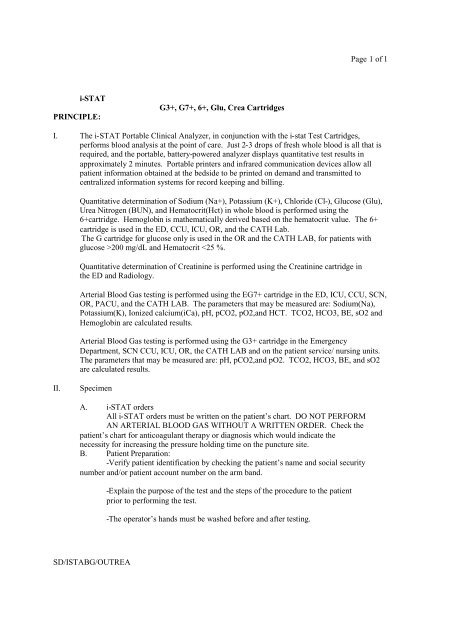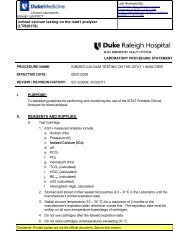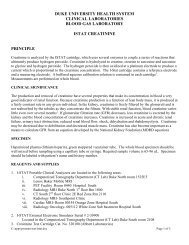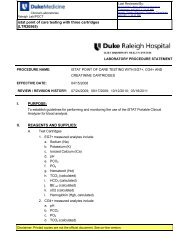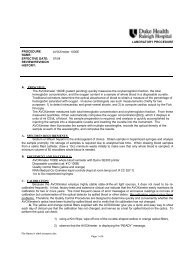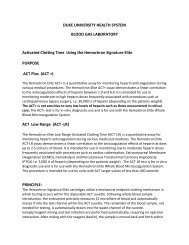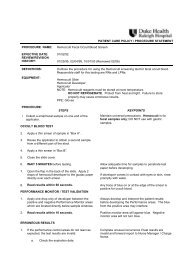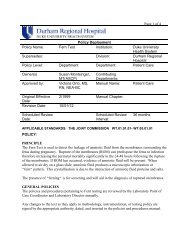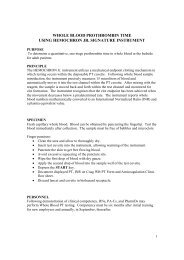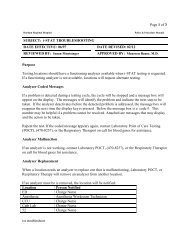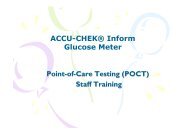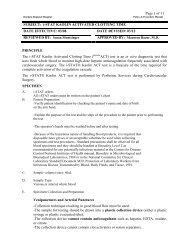i-STAT G3+, G7+, 6+, Glu, Crea Cartridges - Point of Care Testing
i-STAT G3+, G7+, 6+, Glu, Crea Cartridges - Point of Care Testing
i-STAT G3+, G7+, 6+, Glu, Crea Cartridges - Point of Care Testing
- No tags were found...
Create successful ePaper yourself
Turn your PDF publications into a flip-book with our unique Google optimized e-Paper software.
Page 4 <strong>of</strong> 4-Fill the cartridge before icing the sample for transportation. Icing willincrease potassium and will affect oxygen levels in samples collected in plasticsyringes.In-Dwelling Line :Follow the following precautions:-Withdraw slowly three to six times the volume <strong>of</strong> the catheter, connectors, andneedle to remove intravenous solution, heparin, or medications that maycontaminate the sample. Samples collected without anticoagulant should betested within 3 minutes. Samples collected in lithium heparin syringes should betested within 10 minutes and well mixed before use.E. Collection Options:Evacuated tubes (for Venous samples only)-without anticoagulant-with lithium heparin anticoagulant).SyringesVenous samples :-without anticoagulant-with lithium heparin anticoagulantArterial samples:-balanced or low heparin-Blood Gas Syringe KitF. Test Within Time Frames:3 minutes-evacuated tubes or syringes without anticoagulant10 minutes-for evacuated tubes or syringes with anticoagulant(Maintain anaerobic conditions when using syringes) (Evacuated tubes andsyringes must be well mixed before testing)G..Handling ConditionsSD/ISTABG/OUTREA
Page 5 <strong>of</strong> 5If the i-<strong>STAT</strong> cartridge is not filled immediately after collection, the blood must bethoroughly mixed. Mix tubes by gentle inversion 7 times. Mix syringes by rollingbetween the palms 5 times in three directions.H. Criteria For Specimen Rejection-Evidence <strong>of</strong> clotting.-Specimens collected in anticoagulant other than lithium heparin.-Syringe for pH, PCO2, and PO2 with air bubbles in sample.-Other sample types such as urine, CSF and pleural fluid.-Samples not collected according to the specimen type precaution guidelines.I. Sample Transfer DeviceBlunt End Dispensers-To avoid the use <strong>of</strong> needles when transferring a blood sample from an evacuatedtube, a dispenser can be used. Do not use dispensers because that would introduce airinto the sample when ionized calcium, pH or pCO2 are being measured.J. Specimen LabelingIII. Reagent and SuppliesUnless the specimen is analyzed immediately after collection and then discarded, thespecimen container must be labeled with the following information.-Patient's name-Patient's social security number-Time and date <strong>of</strong> collection-Phlebotomist/collector IDA. ReagentsTest <strong>Cartridges</strong>The i-<strong>STAT</strong> Test Cartridge is a self contained testing system. Each cartridge isconsidered a "run", with no reuse <strong>of</strong> reagents or carry-over <strong>of</strong> specimen.The <strong>6+</strong> cartridge contains the following tests:1. SodiumSD/ISTABG/OUTREA
Page 7 <strong>of</strong> 7cartridges if the 14 day time has expired. Do not store cartridges at temperaturesexceeding 30oC.<strong>6+</strong> and <strong>Glu</strong>cose cartridges do not require thermal control and may be used afterstanding just 5 minutes at room temperature. An entire box should stand at roomtemperature for one hour.E<strong>G7+</strong> and <strong>G3+</strong>,and <strong>Crea</strong>tinine cartridges require thermal control (37) and may beused after standing just 5 minutes at room temperature. An entire box should stand atroom temperature for one hour.DO NOT RETURN CARTRIDGES TO THE REFRIGERATOR ONCE THEYHAVE COME TO ROOM TEMPERATURE. <strong>Cartridges</strong> must be usedimmediately after they have been removed from the foil pouch.B. Supplies1. i-<strong>STAT</strong> System Componentsa. Portable Clinical Analyzerb. Electronic Simulatorc. Reagent Cartridged. Printer (hand held)e. IR Interface Cradlef. Disposables (as appropriate for sample application)2. Blood Collection Suppliesa. 2 x 2 Gauzeb. Alcohol Padsc. Tourniquetd. Venipuncture Supplies (Needles, Syringes)e. Vacutainer Tubes (Lithium Heparin)f. Arterial Blood Gas Supplies (Needles, Syringes, lowvolume heparin blood gas syringesIV.Quality ControlA. Calibration and LinearityCalibration is performed internally each time a test cartridge is inserted into thei-<strong>STAT</strong> analyzer with no intervention required on the part <strong>of</strong> the operator. Eachcartridge includes a sealed foil pack which contains a calibrant solution with a knownconcentration <strong>of</strong> each analyte. During the first part <strong>of</strong> the testing cycle the calibratoris automatically forced out <strong>of</strong> the foil pack and over the sensors. The signalsproduced by the sensors in response to the calibrant solution are stored. If thecalibration fails, the i-<strong>STAT</strong> analyzer will give a code and results will not becalculated.SD/ISTABG/OUTREA
Page 9 <strong>of</strong> 9questionable external Electronic Simulator to the LaboratoryDepartment.If FAIL is DISPLAYED with the second external ElectronicSimulator: DO NOT analyze patient samples with theanalyzer. Transmit the results to the Central Data Station.Deliver the faulty analyzer to the laboratory. The <strong>Point</strong> <strong>of</strong><strong>Care</strong> Coordinator will record the failure along with the actiontaken.Remove the external Electronic Simulator after the lockedmessage “LCK” is no longer displayed and return tostorage.The results <strong>of</strong> the external Electronic Simulator, the date,time and operator ID will be transmitted by a RespiratoryTherapist to the Central Data Station via the infrared cradlefor review and record keeping. Radiology and the CATHLAB will transmit their i-<strong>STAT</strong> analyzer each day at the end<strong>of</strong> 1 st shift.Perform the Electronic QC in the following situations:1) When an internal Electronic Simulator fails.2) When an analyzer is brought from a coldenvironment to a hot, humid environment to insurethat any moisture that may have condensed on theinternal connector has evaporated before performingpatient tests.3) When the analyzer's batteries are changed.b. Internal Electronic SimulatorThe internal Electronic Simulator is selected on an 8/24 hourschedule. The internal Electronic Simulator will run every 8hours for pH, pCO2, pO2, hematocrit and ACT channels andevery 24 hours for all other channels.QC Lockout is enabled on all analyzers. This settingprevents analyzers from running a cartridge after a failedinternal Electronic Simulator test.An internal Electronic Simulator is a circuit in the Analyzer which verifies the performance<strong>of</strong> each Analyzer by testing signals consistent with both very low and very highconcentrations <strong>of</strong> each <strong>of</strong> the analytes. The s<strong>of</strong>tware in the analyzer and module measurethese signals as it would measure signals from a cartridge. The s<strong>of</strong>tware checks theSD/ISTABG/OUTREA
Page 10 <strong>of</strong> 10measurements against predetermined thresholds and indicates their acceptability to the usevia a PASS/FAIL message. ACT analyte has quality control tested every 8 hours.The internal Electronic Simulator is triggered by inserting a cartridge.If the s<strong>of</strong>tware detects that the specified time has elapsed since thelast Electronic Simulator test (internal or external), it willautomatically perform the internal test before the sample is tested,adding about 15-20 seconds to the testing cycle. A failed Simulatortest stops the cycle, the FAIL simulator result will be displayed on thescreen, and the sample will not be analyzed. If the test passes, thecartridge cycle continues to completion and the cartridge results aredisplayed.What to do if the Electronic Simulator Fails:Rerun the cartridge in the same Analyzer to ensure the FAIL was notdue to a one-time spike <strong>of</strong> electrical noise. If the test fails again,rerun the cartridge in another Analyzer if immediately available.Note that the cartridge should not be run if there is more than a threeminute delay from the time it is filled. If the cartridge fails in morethan one Analyzer, use another cartridge. In all cases, an externalElectronic Simulator can be used to verify proper performance <strong>of</strong>Analyzer. Failed analyzers are to be brought to the laboratory forreplacement.2. Verification <strong>of</strong> <strong>Cartridges</strong>a. Verification <strong>of</strong> newly received cartridges (performed by theLaboratory Department)i) Verify that the transit temperatures <strong>of</strong> each shipment weresatisfactory using the four window temperature indicator stripaffixed to the cartridge box.ii)iii)iv)From each lot <strong>of</strong> cartridges received, analyze three levels <strong>of</strong>i-<strong>STAT</strong> and Meter Trax Controls each in duplicate, using anyverified analyzer.From each new lot number <strong>of</strong> cartridges received, analyzei-<strong>STAT</strong> calibration verification solutions one, three, and fiveto ensure that patient reference ranges (or reportable ranges)are acceptable from lot to lot. Hematocrit calibrationverification is performed as a separate procedure at aminimum every 6 months (see i-<strong>STAT</strong> CalibrationVerification Procedure).Perform a parallel reagent check by comparing the qualitycalibration verification ranges from the previous lot numbers.SD/ISTABG/OUTREA
Page 11 <strong>of</strong> 11Perform QC on the old cartridge lot number along with thenew cartridge lot number and record results.b. Storage Conditionsi) Refrigerated <strong>Cartridges</strong>a) Verify that the cartridges stored in the designatedChemistry refrigerator are all within the expirationdate printed on the boxes. Deliver any expiredcartridges to the Laboratory <strong>Point</strong> <strong>of</strong> <strong>Care</strong> <strong>of</strong>fice.b) Verify that the Chemistry refrigerator did not exceedthe limits <strong>of</strong> 2-8oC (25-46oF).c) Chemistry will document the refrigerator temperaturedaily.If the temperature <strong>of</strong> the cartridge storage refrigeratoris within the range <strong>of</strong> 2-8oC (35-46oF) use cartridgesas required.If the temperature is outside the range <strong>of</strong> 2-8oC (25-46oF) quarantine the cartridges in the storagerefrigerator. Notify the <strong>Point</strong> <strong>of</strong> <strong>Care</strong> Coordinator,Laboratory Manager, or Supervisor immediately.DO NOT USE the cartridges from the out-<strong>of</strong>-controlrefrigerator. Record the QC failure with the actiontaken via a Laboratory Incident report form.ii.Room Temperature <strong>Cartridges</strong>a) Verify that all boxes <strong>of</strong> cartridges at roomtemperature have been out <strong>of</strong> the refrigerator lessthan two weeks. Deliver any expired cartridges tothe Laboratory <strong>Point</strong> <strong>of</strong> <strong>Care</strong> <strong>of</strong>fice.b) If the measured temperature <strong>of</strong> the room has beencontinuously below 30oC (86oF) use cartridges asrequired.SD/ISTABG/OUTREA
Page 12 <strong>of</strong> 12If the measured room temperature has exceeded 30o(86oF) for any period <strong>of</strong> time: Quarantine thecartridges. Notify the Laboratory <strong>Point</strong> <strong>of</strong> <strong>Care</strong>Coordinator, Laboratory Manager, or Supervisorimmediately. DO NOT use the cartridges. Recordthe out <strong>of</strong> control event and the action taken via aLaboratory Incident report form.3. Comparison <strong>of</strong> test methods for Sodium, Potassium, Chloride, BUN, <strong>Glu</strong>cose,Hematocrit, and <strong>Crea</strong>tinine is performed by the Laboratory <strong>Point</strong> <strong>of</strong> <strong>Care</strong> <strong>of</strong>fice every6 months. (See Comparison <strong>of</strong> Test Methods procedure).4. Pr<strong>of</strong>iciency <strong>Testing</strong> is performed on <strong>6+</strong>, <strong>Crea</strong>tinine and E<strong>G7+</strong> cartridge using CAP’sAQ2 Survey. Laboratory <strong>Point</strong> <strong>of</strong> <strong>Care</strong> performs <strong>6+</strong> pr<strong>of</strong>iciency testing andRespiratory Therapy performs E<strong>G7+</strong> pr<strong>of</strong>iciency testing. Pr<strong>of</strong>iciency testing samplesare shipped three times during the year and include five challenges for each analyte ortest. Samples are tested exactly like patient samples and the results are returned toCAP within 10 working days <strong>of</strong> receipt for grading.5. If any QC result is not within range, take corrective action before any patient samplesare tested.V. PROCEDUREa. Repeat the test.b. If QC is within range, patient testing may proceed.c. If QC is not within range, DO NOT PERFORM PATIENT TESTING.The <strong>Point</strong> <strong>of</strong> <strong>Care</strong> Coordinator will notify i-<strong>STAT</strong> Technical Service.Corrective action taken is recorded in the i-<strong>STAT</strong> Central Data Station and noted onthe i-<strong>STAT</strong> System QC Log.A. Select the Cartridge to be used.<strong>6+</strong> Cartridge is used for stat Electrolytes, BUN, <strong>Glu</strong>cose, and Hematocrit testingin ED, CCU, ICU, OR and the CATH Lab..<strong>Crea</strong>tinine cartridge is used for stat <strong>Crea</strong>tinine in ED and Radiology.E<strong>G7+</strong> Cartridge is used for ABG in Critical <strong>Care</strong> areas: ED, ICU, CCU, SCN, OR,PACU, and the CATH LAB..<strong>G3+</strong> Cartridge is used for ABG in SCN, ED, ICU, CCU, OR, PACU,the CATH LABand on nursing floors/patient care units.SD/ISTABG/OUTREA
Page 13 <strong>of</strong> 13<strong>Glu</strong>cose Cartridge is used in the Operating Room, and CATH LAB for patients withglucose concentrations above 200 mg/d and hematocrits below 25%.The cartridge should be handled as follows to avoid difficulty in filling orrejection by the analyzer:-Do not contaminate the contact pads with finger prints or talc from gloves as theanalyzer may not be able to make proper contact with the cartridge.-Do not exert excessive pressure over the central area <strong>of</strong> the label as the calibrantpack underneath could burst prematurely.-Do not block the air vent as the sample will not be able to flow to the fill markand the calibrant solution will not be able to flow to the sensors.-Do not use a cartridge on which blood or any other fluid is spilled, as theanalyzer’s connector may be contaminated.B. Fill Test Cartridge1. Remove the cartridge from the protective foil pouch after it has come to roomtemperature.2. Place cartridge on a flat surface or hold it horizontally. Do not hold cartridgebetween the fingers if using a syringe with needle to fill the sample well.3. Collect the blood specimen.4. Direct the pipette tip, capillary tube, or needle into the sample well.5. Dispense sample slowly and steadily until it reaches the FILL TO mark (tiltcartridge slightly if necessary). Avoid the introduction <strong>of</strong> air bubbles into thesample well.6. Fill the sample well 1/3 to 2/3 full.7. Once the cartridge is full, complete the procedure without delay.C. Seal Test Cartridge1. Fold the plastic snap closure over the sample well.2. Press on the rounded end <strong>of</strong> the closure until it snaps into place.SD/ISTABG/OUTREA
Page 14 <strong>of</strong> 143. Failure to seal the cartridge will prevent patient testing.D. Insert Test Cartridge into the i-<strong>STAT</strong> Analyzer1. Hold the analyzer firmly in one hand. Grasp the test cartridge by the sides,label facing up, with the other hand.2. Push the cartridge slowly and smoothly through the cartridge door until it willgo no further.The cartridge activates the analyzer. The analyzer displays "CONTACTINGCARTRIDGE" then a time-to-result bar, the cartridge type, "LCK" prompt,and an area in which to enter operator and patient identification numbers.Do not attempt to remove a test cartridge while the "LCK" prompt isdisplayed indicating that the cartridge should not be removed. The forcenecessary to remove the cartridge would damage the analyzer and invalidatethe results.E. Enter Identification Numbers1. Enter your assigned operator identification number. Respiratory Therapistsuse your LIS numerical Tech Code. All other operators use the first 6 digits<strong>of</strong> your social security number. Use the numerical keypad to enter thenumber. Press the "CLR" key to backspace and erase a wrong number. Pressthe "ENT" key to enter the completed number.2. After the ENT key is pressed, the prompt "Repeat #, ENT" appears in the box.Repeat the operator identification number as above and press ENT to signalthe analyzer that the last digit has been entered.3. Enter the patient's account number, not the patient social security number, inthe same manner as the operator ID number.4. If either the operator identification or the patient identification numbers arenot entered correctly in duplicate, the message "ID DID NOT MATCHSTART AGAIN" will display. Re-enter the ID number that was in error.Operating rooms and “codes” present a unique testing situation in that tests arerun repeatedly on the same patient. Pressing the DIS key when promptedfor Patient ID will recall the last Patient ID entered into the analyzer. Therepeat request for Patient ID may also be entered by pressing the Display key.F. Enter Blood Gas and Patient InformationSD/ISTABG/OUTREA
Page 15 <strong>of</strong> 15After the patient identification number is entered, the PAGE key is activated allowingaccess to an additional data entry screen. (If results are already displayed, press thePAGE key twice to access the data entry screen).The cursor will be flashing at the first input area. Use the numbered keys to inputinformation and press the ENT key to advance to the next input area (or to return tothe first area from the last input area). Invalid numbers will be ignored, and incorrectinputs can be corrected using the CLR key as a backspace.Pt TempEnter the patient’s temperature in degrees Fahrenheit or Centigrade.Use the * key to enter a decimal point. The analyzer will interpretnumbers between 50.0 and 110.0 as degrees Fahrenheit andbetween10.0 and 45.0 as degrees Centigrade.FIO2 Enter the FIO2 value as a whole number from 0 to 100,representing the number <strong>of</strong> liters or a percentage <strong>of</strong> theoxygen the patient is receiving. Use the * key to enter a decimalpoint.Free Field 1:(6 spaces)DEL MODE RATEPRESSURESYSSUPPORTDelivery System:(1 space) Mode:(1 space) Rate:(2 spaces) PS:(2 spaces)0= room air 1= AC 0-991= nasal can 2= SIMV if RR
Page 16 <strong>of</strong> 16Tidal Volume (3 spaces)PEEP (2 spaces)NOTIFIEDFree Field 3: (4 spaces)SITE DRAWN BY ALLENS TEST MDCollection Site Drawn By Allens Test MD Notified1= R Rad 1= operator 1=yes1= yes2= L Rad 2=RN 2= no2= no3= R Brach 3=RT4= L Brach 4= MD5= R Fem6= L Fem7= art line8= UAC9= UVCSample TYPE Enter the number corresponding to the sample type:1 ART(arterial) 2 VEN (venous)3 CAP(capillary)4 CORD 5MXVN(mixed venous)6 CPB(cardiopulmonarybypass)When 6(CPB) is chosen as the sample type, a special algorithm for hematocritvalues is used. The algorithm infers a total protein level, assuming the pumppriming solution dilutes the hematocrit and total protein equally. An adjustedhematocrit value is reported Hct,CPB on both the analyzer display and printout.After data entry is completed the free fields may be edited until the results are printedor transmitted to the Central Data Station or until a new cartridge or externalElectronic Simulator is run.G. View ResultsThe Portable Clinical Analyzer will display test results once the cartridge has beenunlocked and the LCK prompt disappears. Results will be displayed for 45 seconds .Results can be recalled to the display screen by pressing the display key.H. Results should either be transcribed onto the patient’s medical record ortransmitted to the portable printer or the Central Data StationI. Remove the Test CartridgeSD/ISTABG/OUTREA
Page 17 <strong>of</strong> 171. Remove the cartridge any time after the "LCK" prompt disappears from thedisplay screen. Discard the cartridge in an appropriate Biohazard Wastereceptacle.2. The analyzer display will deactivate after 45 seconds to save the battery. The lastresults can be recalled by pushing "DISPLAY".3. Once a cartridge is removed, even if results are still displayed, the analyzer isready to accept another cartridge.VII.CalculationsThe i-<strong>STAT</strong> Portable Clinical Analyzer contains a microprocessor that performs allcalculations required for reportable results.VIII.Reporting ResultsThe i-<strong>STAT</strong> Analyzer will produce an audible beep as soon as the results are displayed. Theresults are displayed in numerical and bar graph forms. Results may be recorded on thepatient's chart directly from the i-<strong>STAT</strong> LED display or printed and the printout placed on thepatient's chart until the patient's laboratory cumulative summary is charted. The i-<strong>STAT</strong> willaccumulate a total <strong>of</strong> 50 test records (patients, control material, and electronic simulator tests).All information will be transmitted to the Central Data Station, located in the Laboratory, viathe IR Cradle.Test results are displayed showing numerical concentration values. Bar graphs which depictthe values in relation to reference ranges are also displayed. Blood gas results are notdisplayed with reference ranges. The reference range is marked on the bar by tick marks.When all test values are within their reference ranges, the tick marks will be centrallyaligned. The bar graphs can be used as a visual cue for distinguishing between “normal” and“abnormal” results.A. LinearityThe reportable range for i-<strong>STAT</strong> constituents are as follows:TESTSNaKClBUNSD/ISTABG/OUTREA
Page 18 <strong>of</strong> 18<strong>Glu</strong>HctHgb (calculated)<strong>Crea</strong>iCApHPO2PCO2HCO3TCO2Base Excess/BEResult Out <strong>of</strong> Reportable (Linear) Range:1. If a "" sign precedes a value or if a "< >" sign is displayed, thevalue exceeded the linear range <strong>of</strong> measurement for that particular test.2. Report the “< or >” result immediately to the patient’s attending physicianor nurse. <strong>6+</strong>cartridge results must be repeated by laboratory analysis.A lithium heparin (green stoppered) tube must be collected for Electrolyte,BUN , and <strong>Glu</strong>cose verification. An EDTA (lavender stoppered) tube mustbe collected for Hematocrit verification. The test to be repeated must beordered in SMS as <strong>STAT</strong>. The patient will be credited by Laboratory <strong>Point</strong><strong>of</strong> <strong>Care</strong> for all verification repeats.B. Results Displayed1. Test results are displayed in numerical concentrations and on the bar graph.Results are direct readout; no calculation is necessary. There are fourexceptions to the direct readout when the results are not reportable:a. Uncharacteristic ResultsSD/ISTABG/OUTREA
Page 19 <strong>of</strong> 19[****] is displayed in place <strong>of</strong> one or more results when a signal froma sensor is uncharacteristic. This may be due to a defective sensor oran interferant in the sample. If [****] is displayed repeat the test witha fresh cartridge. If [****] is still displayed on the <strong>6+</strong>cartridge result,the physician may request a repeat by laboratory analysis. Followsteps VIII, A, 2 for repeating an i-<strong>STAT</strong> result by laboratory analysis.b. Results Out <strong>of</strong> Reportable (Linear) RangeSee above section on Linearity.c. Results Which Exceed Critical Limits (Alert Values)i. Results which exceed the laboratory established "AlertValues" represent an emergency condition.ii.If critical test result for venous Electrolytes or Hematocrit iswithin the i-<strong>STAT</strong> Analyzer's reportable range repeat the testfor verification with a fresh test cartridge and report theresult.repeated.iii.The established Alert Values are as follows:<strong>Glu</strong>cose >350 mg/dL must be verified by repeat in thelaboratory except for OR patients. The physician willdetermine if repeat verification is to be done. Follow stepVIII, A,2 for repeating an i-<strong>STAT</strong> result by laboratoryanalysis.ABG alert values are NOT repeated. Arterialelectrolytes, ionized Calcium, and Hematocrit are NOTAll results which exceed Critical Limits must be brought tothe physician or RN responsible’s attention immediatelyeither by phone call or direction notification. Physician orRN notification <strong>of</strong> the Alert Value must be documented onthe patient's chart. Respiratory Therapists will give all resultsdirectly to the physician or RN. Physician/RN notification isentered into the i-<strong>STAT</strong> analyzer and reported on the ABGpatient report.Alert values repeated by i-<strong>STAT</strong> only will have a CriticalValue Documentation Verification form sent to the nursemanager or designee. The form must be completed andreturned to Laboratory <strong>Point</strong> <strong>of</strong> <strong>Care</strong>.SD/ISTABG/OUTREA
Page 20 <strong>of</strong> 20NaK<strong>Glu</strong>HctiCapHPO2PCO2Any neonate glucose result below 45 mg/dL or above 150mg/dLshould be followed up according to the Neonate Blood <strong>Glu</strong>cose<strong>Testing</strong> procedure located in the Nursing unit procedure manual.d. Test cycle not completed due to problem with the sample, calibrantsolution, sensors, mechanical or electrical functions <strong>of</strong> the analyzer:take the action displayed with the message that identifies the problem.Refer the problem to the Laboratory <strong>Point</strong> <strong>of</strong> <strong>Care</strong> Coordinator ifnecessary.2. Display Stored Results:C. Printing Results:To recall a stored test record to the display screen, press the MENU s<strong>of</strong>t keyand select STORED RESULTS by pressing the "2" key, from the STOREDRESULTS menu, select DISPLAY A RESULT by pressing the "1" key.Select the record to be displayed by pressing the key (1 to 5) on the pages (1to 10) corresponding to the test record. The list <strong>of</strong> stored results can be listedwith Cartridge Type or Date/Time. Use the DIS key to toggle between thesedisplay modes.1. Place the analyzer in the printer cradle. Turn the printer on (printer lightgreen) or press the paper advance key to reactivate.SD/ISTABG/OUTREA
Page 21 <strong>of</strong> 212. To print the displayed test record, press the PRT key on the analyzer. Themost recent test record can be printed only if a patient identification numberhas been entered or actively bypassed.3. Do not move the analyzer while "Printing" is displayed. Note: Resultsprinted on thermal paper will fade with time and, therefore, not acceptable aspermanent chartable record.4. Write the patient's name on the Pt name line, the physician's name on thePhysician line, and the Sample type on the Sample type line.5. A stored test record can be printed without recalling the results to the screen.Press the MENU s<strong>of</strong>t key, select STORED RESULTS by pressing the "2"key. From the STORED RESULTS Menu select PRINT RESULTS bypressing the "2" key. Use the s<strong>of</strong>t keys to page up or down through the 10pages <strong>of</strong> stored test records, press the 1 to 5 keys to select the desired recordson each page. When a key is pressed, the number selected will reserve video(dark background, light lettering). To deselect a record, re-press the key, thenumber will return to light background, dark lettering.The list <strong>of</strong> stored results can be listed with Cartridge Type or Date/Time.Use the DIS key to toggle between these display modes. When all the testrecords desired are selected, press the PRT key. The message"PRINTING..." will be displayed while the records are transmitted to theprinter. Each record will take about 45 seconds to print.6. To stop printing before all test records are printed, press the * key.7. A test record cannot be printed from a position displaying INVALID or NODATA, an Electronic Simulator test or an error code.D. Transmitting Results to the Central Data Station1. i-<strong>STAT</strong> operators will transmit Arterial Blood Gas (ABG) resultsimmediately after completion <strong>of</strong> each ABG test.Respiratory Therapy will transmit all results from each analyzer that ABGsare performed on at the beginning <strong>of</strong> each shift.Radiology will transmit all results at the end <strong>of</strong> first shift, Monday throughFriday.The Cardiac Cath Lab will transmit all results at the end <strong>of</strong> each case.2. Place the analyzer in the IR Interface cradle. The IR Interface light must begreen.SD/ISTABG/OUTREA
Page 22 <strong>of</strong> 223. To transmit all stored test records, press the * key or access STOREDRESULTS from the menu. Press the "3" key on the analyzer to transmit alltest records.4. Do not move the analyzer while "Transmitting" is displayed.5. During transmission the IR Interface light will blink alternately red and green.If transmission is successful, the interface will emit a single high pitchedbeep, and the light will return to green. An unsuccessful transmission isindicated by three low tone beeps. In this case repeat the transmissionprocess. If unsuccessful the second time, notify the Laboratory <strong>Point</strong> <strong>of</strong> <strong>Care</strong>Coordinator.E. Transmitting Results from the Central Data Station to the Lab Computer.Test records will be routinely transmitted to LIS automatically via an AME interface.The Laboratory <strong>Point</strong> <strong>of</strong> <strong>Care</strong> Office will transmit results manually from the CentralData Station to the Laboratory Information System when AutoSend is <strong>of</strong>f:1. Use the up and down arrow keys on the Central Data Station to highlight thepatient test record to be transmitted.2. Press the F9 key.3. "_ _ _" indicates that the record is in queue.4. ". . ." indicates the record is being transmitted.5. A check mark in the Central Data Station SENT column indicates that theresults have been transmitted.6. Activate the Auto Send "on" to resume automatic transmission.F. Reference RangeThe i-<strong>STAT</strong> Reference Ranges have been derived from the literature and areprogrammed into the i-<strong>STAT</strong> Analyzer. The reference ranges are as follows:NaSD/ISTABG/OUTREA
Page 23 <strong>of</strong> 23KClBUN<strong>Glu</strong>HctHgb<strong>Crea</strong>iCApHPO2sO2PCO2HCO3TCO2BaseExcess/BEThe reference ranges listed below are those used by Durham Regional Hospital Laboratory(serum/plasma samples for chemistries). Sodium, Potassium, Chloride, BUN, <strong>Glu</strong>cose, Hematocrit,Hemoglobin, and <strong>Crea</strong>tinine values have been established by in-house normal range studies andavailable literature. Arterial Blood Gases and ionized Calcium have been derived from the literature.SD/ISTABG/OUTREA
Page 24 <strong>of</strong> 24NaKClBUN<strong>Glu</strong>Hct-SD/ISTABG/OUTREA
Page 25 <strong>of</strong> 25HgbHgb<strong>Crea</strong>iCapHPO2SD/ISTABG/OUTREA
Page 26 <strong>of</strong> 26PCO2sO2IX.Clinical SignificanceSodiumTest for sodium in the blood are important in the diagnosis and treatment <strong>of</strong> patients suffering fromhypertension, renal failure or impairment, cardiac distress, disorientation, dehydration, nausea anddiarrhea. Some causes <strong>of</strong> increased values for sodium include dehydration, diabetes insipidus, saltpoisoning, skin losses, hyperaldosteronism and CNS disorders. Some causes for decreased values forsodium include delusional hyponatremia (cirrhosis), depletional hyponatremia and syndrome <strong>of</strong>inappropriate ADH.PotassiumTests for potassium in the blood are important in the diagnosis and treatment <strong>of</strong> patients sufferingfrom hypertension, renal failure or impairment, cardiac distress, disorientation, dehydration,nausea and diarrhea. Some causes <strong>of</strong> increased values for potassium include renal glomerular disease,adrenocortical insufficiency, diabetic ketoacidosis (DKA), sepsis and in vitro hemolysis. Some causes<strong>of</strong> decreased values for potassium include renal tubular disease, hyperaldosteronism, treatment <strong>of</strong>DKA, hyperinsulinism, metabolic alkalosis and diuretic therapy.ChlorideTests for chloride in the blood are important in the diagnosis and treatment <strong>of</strong> patients suffering fromhypertension, renal failure <strong>of</strong> impairment, cardiac distress, disorientation, dehydration, nausea anddiarrhea. Some causes <strong>of</strong> increased values for chloride include prolonged diarrhea, renal tubulardisease, hyperparathyroidism and dehydration. Some causes for decreased values for chloride includeprolonged vomiting, burns, salt-losing renal disease, overhydration and thiazide therapy.Urea Nitrogen/BUNAn abnormally high level <strong>of</strong> urea nitrogen in the blood is an indication <strong>of</strong> kidney function impairmentor failure. Some other causes <strong>of</strong> increased values for urea nitrogen include prerenal azotemia(e.g. shock), postrenal azotemia, GI bleeding and high protein diet. Some causes <strong>of</strong> decreased values<strong>of</strong> urea nitrogen include pregnancy, severe liver insufficiency, overhydration and malnutrition.<strong>Glu</strong>cose<strong>Glu</strong>cose is a primary energy source for the body and the only source <strong>of</strong> nutrients for the brain issue.Measurements for determination <strong>of</strong> blood glucose levels are important in the diagnosis and treatment<strong>of</strong> patients suffering from diabetes and hypoglycemia. Some causes for increased values <strong>of</strong> glucoseinclude diabetes mellitus, pancreatitis, endocrine disorders (e.g. Cushings syndrome), drugs (e.g.steroids, thyrotoxicosis), chronic renal failure, stress, or I.V. glucose infusion. Some causes <strong>of</strong>decreased values <strong>of</strong> glucose include insulinoma, adrenocortical insufficiency, hypopituitarism,massive liver disease, ethanol ingestion, reactive hypoglycemia, and glycogen storage disease.SD/ISTABG/OUTREA
Page 27 <strong>of</strong> 27HematocritHematocrit is a measurement <strong>of</strong> the volume <strong>of</strong> red blood cells. This is a key indicator <strong>of</strong> the body'sstate <strong>of</strong> hydration, anemia or severe blood loss, as well as the blood's ability to transport oxygen.Some causes <strong>of</strong> increased values <strong>of</strong> hematocrit include dehydration,burns, impaired ventilation andrenal disorders. Some causes for decreased values <strong>of</strong> hematocrit include hemolytic anemias, irondeficiency, marrow depression or blood loss.<strong>Crea</strong>tinineElevated levels <strong>of</strong> creatinine are mainly associated with abnormal renal function and occur wheneverthere is a significant reduction in glomerular filtration rate or when urine elimination is obstructed.The concentration <strong>of</strong> creatinine is a better indicator <strong>of</strong> renal function than urea or uric acid because itis not affected by diet, exercise or hormones.Ionized CalciumAlthough most <strong>of</strong> the calcium in blood is bound to protein or complexed to smaller anionic species,the biologically active fraction <strong>of</strong> calcium is free ionized calcium. Through its role in a number <strong>of</strong>enzymatic reactions and in membrane transport mechanisms, ionized calcium is vitally important inblood coagulation, nerve conduction, neuromuscular transmission and in muscle contraction.Increased ionized calcium (hypercalcemia) may result in coma.Other symptoms reflect neuromusculardisturbances, such as hyperreflexia and/or neurologic abnormalities such as neurasthenia, depressionor psychosis. Decreased ionized calcium <strong>of</strong>ten results in cramps (tetany), reduced cardiac stroke workand depressed left ventricular function. Prolonged hypocalcemia may result in bone demineralization(osteoporosis) which can lead to spontaneous fractures. Measurments <strong>of</strong> ionized calcium have proven<strong>of</strong> value under the following clinical conditions: transfusion <strong>of</strong> citrated blood, liver transplantation,open heart surgery, neonatal hypercalcemia, renal disease, hyperparathyroidism, malignancy,hypertension, and pancreatitis.pHpH is an index <strong>of</strong> the acidity or alkalinity <strong>of</strong> the blood with an arterial pH <strong>of</strong> 7.45 alkalemia.PO2PO2 (partial pressure <strong>of</strong> oxygen) is a measurement <strong>of</strong> the tension or pressure <strong>of</strong> oxygen dissolved inblood. Some causes for decreased values <strong>of</strong> PO2 include decreased pulmonary ventilation, impairedgas exchange between alveolar air and pulmonary capillary blood, and alteration in the flow <strong>of</strong> bloodwithin the heart or lungs.PCO2PCO2 along with pH is used to assess acid-base balance. PCO2 (partial pressure <strong>of</strong> carbon dioxide),the respiratory component <strong>of</strong> acid-base balance, is a measure <strong>of</strong> the tension or pressure <strong>of</strong> carbondioxide dissolved in the blood. Causes <strong>of</strong> primary respiratory acidosis (increase in PCO2 ) are airwayobstruction, sedatives and anesthetics, respiratory distress syndrome, and chronic obstructivepulmonary disease. Causes <strong>of</strong> primary respiratory alkalosis (decreased PCO2) are hypoxia due tochronic heart failure, edema and neurologic disorders, and mechanical hyperventilation.HCO3 (bicarbonate)SD/ISTABG/OUTREA
Page 28 <strong>of</strong> 28HCO3 (bicarbonate) is an indicator <strong>of</strong> the buffering capacity <strong>of</strong> blood. Regulated primarily by thekidneys, HCO3 is the metabolic component <strong>of</strong> acid-base balance. Causes <strong>of</strong> primary metabolicacidosis are ketoacidosis , lactate acidosis, and diarrhea. Causes <strong>of</strong> primary metabolic alkalosis arevomiting and antacid treatment.TCO2 (total carbon dioxide)TCO2 (total carbon dioxide) is a measure <strong>of</strong> carbon dioxide which exists in several states: CO2 inphysical solution or loosely bound to proteins. Bicarbonate ions make up all but approximately2mmol/L <strong>of</strong> the total carbon dioxide <strong>of</strong> plasma. Measurement <strong>of</strong> TCO2 as part <strong>of</strong> an electrolytepr<strong>of</strong>ile is useful chiefly to evaluate HCO3 concentration. TCO2 and HCO3 are useful in theassessment <strong>of</strong> acid-base imbalance (along with pH and PCO2) and electrolyte imbalance.Base Excess/BEBase excess remains virtually constant during acute changes in the PCO2 and reflects onlynonrespiratory component <strong>of</strong> pH disturbances.X. Limitations <strong>of</strong> ProcedureProper venipuncture technique must be followed to avoid hemolysis <strong>of</strong> the sample or tissue fluidcontamination.Interferences:Hydroxurea(Droxia, Hydrea)Hydroxyurea can cause significant errors in the measurement <strong>of</strong> <strong>Glu</strong>cose, and <strong>Crea</strong>tinine with thei-<strong>STAT</strong> system. An alternate method must be used to measure <strong>Glu</strong>cose and <strong>Crea</strong>tinine whenpatient’s have been administered hydroxyurea..Hemodilution <strong>of</strong> the plasma by more than 20% associated with priming cardiopulmonary bypasspumps, plasma volume expansion or other fluid administration therapies using certain solutions maycause clinically significant error on Sodium, Chloride, Ionized Calcium, and pHresults. These errors are associated with solutions that do not match the ionic characteristics <strong>of</strong>plasma. These errors can be avoided if when hemodiluting by more than 20%, physiologicallybalanced multi-electrolyte solutions containing low-mobility anions (e.g. gluconate) such asNormosol-R (Abbott Laboratories). Plasma-Lyte-A (Baxter Healthcare Corporation), andIsolyte-S (B Braun Medical) are used.ThiocyanateThiocyanate is a degradation product product <strong>of</strong> nitroprusside treatment and also a product <strong>of</strong>thiosulphate treatment <strong>of</strong> cyanide poisoning.It may cause falsely elevated Chloride results, or may cause chloride results to be suppressed (“starout”).SD/ISTABG/OUTREA
Page 29 <strong>of</strong> 29It can cause falsely decreased BUN/urea, and <strong>Glu</strong>cose results. Preliminary studies indicated that140mg/dL (24mmol/L) thiocyanate decreased BUN/urea results approximately 21%, and decreased<strong>Glu</strong>cose results approximately 23%.Bromide37.5 mmol/L bromide will increase Sodium results by 5 mmol/L, and decrease <strong>Glu</strong>cose by 30mg/L..12.5mmol/L (100mg/dL) bromide will increase Chloride results by 30 mmol/L, and will increase<strong>Crea</strong>tinine by 0.8mg/dL (71 umol/L) from an initial creatinine concentration <strong>of</strong> 1.0 mg/dL (88umol/L).Lactate20 mmol/L lactate will decrease Sodium results by 5 mmol/L, and decrease Ionized Calcium resultsby 0.05 mmol/L..11 mmol/L (100 mg/dL) lactate will increase Chloride results by 3.5 mmol/L.B-hydroxybutyrate16 mmol/L (166 mg/dL) B-hydroxybutyrate will decrease Sodium results by 5 mmol/L, and willincrease Chloride results by 3 mmol/L..20 mmol/L B-hydroxybutyrate will decrease Ionized Calcium results by 0.1 mmol/L.Salicylate4 mmol/L salicylate will increase Chloride results by 5 mmol/L.4.34 mmol/L salicylate will decrease Ionized Calcium results by 0.1 mmol/L.Magnesium1.0 mmol/L magnesium above normal will increase Ionized Calcium results by 0.04 mmol/L.Ascorbate11 mmol/L ascorbate will cause a 0.7 mg/dL increase in <strong>Crea</strong>tinine.A. SodiumThe use <strong>of</strong> blood collection tubes containing sodium heparin as an anticoagulant mayincrease sodium results up to 1 mmol/L.SD/ISTABG/OUTREA
Page 30 <strong>of</strong> 30B. PotassiumIf heparanized whole blood is allowed to stand before testing, potassium values will firstdecrease slightly, then increase over time. Potassium will increase in iced specimens.Potassium values from anticoagulated samples are preferred to serum values because 0.1 to0.7 mmol/L potassium can be released from platelets and red blood cells during the clottingprocess. Potassium values obtained from skin puncture samples may vary due to hemolysisor an increase in tissue fluid from improper technique during the collection procedure.E. <strong>Glu</strong>cose<strong>Glu</strong>cose values will decrease in whole blood samples over time. Venous blood glucose is asmuch as 7 mg/dL less in capillary blood glucose as a result <strong>of</strong> tissue utilization..pHPO2Values below 7.4 at 37 Cdecrease results by approximately0.9 mg/dL (0.05 mmol/L) per 0.1 pH units. Values above7.4 at 37 Cincrease results by approximately 0.8 mg/dL (0.04 mmol/L) per0.1 pH units.Oxygen levels <strong>of</strong> less than 20mmHg (2.66 kPa) at 37 C maydecrease results.F. HematocritGrossly elevated WBC counts may increase results.High Hematocrit results can be caused by settling <strong>of</strong> red blood cells in the sample.Low hematocrit results can be caused by contamination from flush solutions in an arterial orvenous line.Hematocrit results are affected by the level <strong>of</strong> total protein as follows:For HCT values below 40%PCV:For Total Protein values below 6.5g/dL, HCT decreased by 1% PCV for eachdecrease <strong>of</strong> 1g/dL TP.For Total Protein values above 8.0g/dL, HCT increased by 1% PCV for eachincrease <strong>of</strong> 1g/dL TP.For HCT values above 40%PCV:SD/ISTABG/OUTREA
Page 31 <strong>of</strong> 31For Total Protein values below 6.5g/dL, HCT decreased by 0.75% PCV for eachdecrease <strong>of</strong> 1g/dL TP.For Total Protein values above 8.0g/dl, HCT increased by 0.75%PCV for eachincrease <strong>of</strong> 1g/dL TP.Abnormally high lipids may increase results. Interference from lipids will be abouttwo thirds the size <strong>of</strong> the interference from protein.The sample electrolyte concentration is used to correct the measured conductivityprior to reporting hematocrit results. Factors that affect sodium will therefore alsoaffect hematocrit.G. Ionized calciumH. pHI. PO2Venous stasis (prolonged tourniquet application) and forearm exercise mayincrease ionized calcium due to a decrease in pH caused by localizedproduction <strong>of</strong> lactic acid. Exposing the sample to air will cause an increasein pH due to the loss <strong>of</strong> CO2 which will decrease ionized calcium.Heparin binds calcium. Each unit <strong>of</strong> heparin added per mL <strong>of</strong> blood willdecrease ionized calcium by 0.01mmol/L. The correct ratio <strong>of</strong> heparinanticoagulant to blood must be achieved during sample collection.Intravenous injection <strong>of</strong> 10,000 units <strong>of</strong> heparin has been shown inadults to cause a significant decrease <strong>of</strong> ionized calcium <strong>of</strong> about0.03mmol/L.Affect <strong>of</strong> Freezing: <strong>Cartridges</strong> should be stored between 2 and 8 C. Freezing should beavoided. Freezing will cause the ionized calcium in the calibrant fluid to precipate, whichwill cause sample results to be falsely elevated. To help avoid freezing, do not storecartridges against the walls <strong>of</strong> the refrigerator. If freezing is suspected, test a sample <strong>of</strong> thecartridges using i-<strong>STAT</strong> controls.Venous stasis and forearm exercise may decrease pH due to localized production<strong>of</strong> lactic acid. Exposing the sample to air will cause an increase in pH due to theloss <strong>of</strong> CO2. pH decreases on standing anaerobically at room temperature at arate <strong>of</strong> 0.03 pH units per hour.Exposure <strong>of</strong> the sample to air will cause an increase in PO2 when values are below150 mmHg and a decrease in PO2 when values are above 150 mmHg (approximate PO2<strong>of</strong> room air).SD/ISTABG/OUTREA
Page 32 <strong>of</strong> 32Standing anaerobically at room temperature will decrease pH at a rate <strong>of</strong> 0.03 perhour, will increase PO2 by approximately 4mmHg per hour and will decrease PO2at a rate <strong>of</strong> 2-6 mmHg per hour.Do not ice samples before testing-PO2 results may be falsely elevated in cold samples. Donot use a cold cartridge.-PO2 results may be falsely decreased if the cartridge is cold.sO2 values calculated from a measured PO2 and an assumed oxyhemoglobindissociation curve may differ significantly from the direct measurement.J. PCO2, TCO2,HCO3Exposing the sample to air allows CO2 to escape which causes PCO2 to decreaseand pH to increase and HCO3 and TCO2 to be under-estimated.Allowing blood to stand (without exposure to air) before testing allows PCO2 toincrease and pH to decrease which will cause HCO3 and TCO2 to be overestimateddue to metabolic processes.K. <strong>Crea</strong>tinineFor <strong>Crea</strong>tinine values below 2 mg/dL:For PCO2 values above 40, creatinine values are increased by 6.9% for every 10mmHgFor PCO2 values below 40, creatinine values are decreased by 6.9% for every 10mmHg.For <strong>Crea</strong>tinine values above 2 mg/dL:For PCO2 values above 40, creatinine values are decreased by 3.7% for every 10mmHgFor PCO2 values below 40, creatinine values are increased by 3.7% for every 10mmHg.A creatine level <strong>of</strong> 5 mg/dL will cause a 0.20 mg/dL increase in <strong>Crea</strong>tinine. <strong>Crea</strong>tinemay be elevated in patients using creatine supplements, experiencing muscle traumaor other primary or secondary myopathies, taking statins for hyperlipidemia control, orin patients with hypothyroidism or a rare genetic defect <strong>of</strong> the creatine transporterprotein.XI.ReferenceA. i-<strong>STAT</strong> Cartridge and Test Information Sheets for Sodium, Potassium,Chloride, <strong>Glu</strong>cose, BUN, Hematocrit, revised November 1996. The i-<strong>STAT</strong>Corporation, Princeton, New Jersey.B. i-<strong>STAT</strong> System Manual, revised October 2003. The i-<strong>STAT</strong> Corporation,Princeton, New JerseySD/ISTABG/OUTREA
Page 33 <strong>of</strong> 33C. Tietz, Norbert W., Clinical Guide to Laboratory Tests, pp. 446-447, pp 398-399, pp. 110-111, pp. 230-231, pp. 492-493, pp. 258-259, W. B Saunderscompany, Philadelphia, PA., 1983.Procedure Written By: Kathryn Winston, 10/04Procedure Revised By: Kathryn Winston, 10/94, 11/95, 8/96, 6/97, 10/97,5/98,7/98,11/98,11/99,2/00,3/00,10/00,1/01,6/01,11/01, Susan Montsinger 4/04, 5/05Procedure Reviewed By:________________________________ __________________________________John T. Daly, M.D. Date Mark Powers, M.D. DateDRH Laboratory DirectorDirector <strong>of</strong> Arterial Blood Gas Laboratory________________________________Susan Montsinger BS,MT(ASCP) Date<strong>Point</strong> <strong>of</strong> <strong>Care</strong> Coordinator_________________________________Charles Alford, RRTDirector <strong>of</strong> Cardiopulmonary ServicesSD/ISTABG/OUTREA


